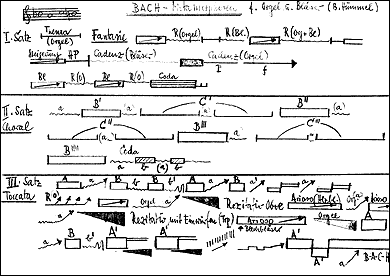Metamorphoses on B-A-C-H for Organ and Winds Op. 40 (1971)
I. Fantasy
II.
Chorale ![]() beginning
beginning
III.
Toccata ![]() beginning
beginning
Instrumentation: 2 Ob., Cor Angl., 2 Bssn., 3 Trp.in C<1st or high B-flat>, 3 Trb.
Première:
November 28, 1971
/ Würzburg / Kiliansdom
Paul Damjakob / Kurt Hausmann / Yashuhito Yamamoto
/ Ernst-Martin Eras / Karl Kolbinger / Eberhard Buschmann / Edward-Tarr-Bläserensemble
Conductor:
Christian Fröhlich
Duration: 18 Minutes
Publisher: N. Simrock Hamburg-London (Boosey & Hawkes)
Video: Works by Hummel on youtube
The cycle in three movements "Metamorphoses on the Name B-A-C-H", op. 40 (composed in 1971) originates in the famous four note model (in English: B-flat - A - C - B), used by Bach himself, which has fascinated and inspired composers of all periods. Here it is fused with twelve-tone techniques and forms the basis for a multitude of chordal and melodic shapes. At the beginning of the 1st movement, it is presented motto-like in its original form by the organ, before reappearing transposed, transformed and manifoldly re-worked in the form of a fantasy.
There is not one bar of this music in which the second-third-second model does not appear in some way. The form of the piece is initially determined by the dialogue conducted block-wise between organ and wind ensemble standing in opposition to each other, only to become increasingly intermeshed with each other as the movement becomes more concentrated or else at a decisive moment to stand in cadenza-like isolation. At the centre of the composition is the chorale in the solo trumpet, "Wenn ich einmal soll scheiden" - the thought of death. The work is dedicated to the memory of the composer’s mother and takes inspiration from the great Passions of Bach. The phrases of the chorale are set in a frame of filigree melody and brass tutti, both of these in their turn developed from the four note B-A-C-H model. The baroque Toccata with its cumulative series of contrasting and exuberantly played sections offered a model for the final movement. Here the contrasting sections - weighty towers of sound, virtuoso passage work and cantabile wind ariosi - succeed each other without any trace of arbitrariness without context: the notes B-A-C-H, which shine out again at the very last close in their original form, provide coherence.
Klaus H. Stahmer 1984

Graphical overview of the composing process
Press
Fränkisches Volksblatt, 28th January, 1985
At the end a climax certainly not of this concert alone: Bertold Hummel’s "Methamorphoses on B-A-C-H", a deeply painful, great work.
Nürnberger Nachrichten, 1st December, 1971
Counterpoint and dazzling chains of clusters, minutely chiselled filigree work and massive agglomerations of sound form in this opus the lofty vaults of a generous, baroque-like architecture in sound. In the first movement, "Theme-Fantasy", the B-A-C-H motif crosses in different variations between organ and wind instruments; in the Chorale movement, the spectrum of sound is widened but is repeatedly extinguished to allow sharply defined extended chorale-like lines to appear in paraphrase. Organ, brass and woodwind reach an imposing tutti climax in the third movement, entitled "Toccata".
Schwäbische
Zeitung, 11th December, 1971
Hummel uses in his work in three movements - Fantasy, Chorale, Toccata - the theme as a building block, as a constantly recurring point of reference. But how differently he has treated the motif than his predecessors! He uses the classical contrapuntal method; but beyond the normal inversion, crab, elevation or lowering (as much as a minor second), canon and fugato there are new structures: with massings of bulbs of sound, dissonant garlands, broken-off thrusting chords. Hummel knows how to combine the - apparently mutually contradictory - musical worlds into the synthesis of an internally harmonious expression in sound. The Fantasy takes its vigour from the constantly varying dialogue between organ (with quasi cadenza) and wind. The second movement, titled Chorale, working with large surfaces of sound, has Haßler's melody "O Haupt voll Blut und Wunden" sounding distantly as counter-theme. In the monumental Toccata, the B-A-C-H motifappears with ever-increasing intensity in multifarious treatments as far as dissolving into runs and note-concentrations in the organ, free solo (oboe, trumpet), with the transparency of chamber-music and finally a full tutti.
Badische
Zeitung, 5th July, 1986
A most impressive interpretation of the "Metamorphoses on B-A-C-H". Under the competent direction of M. Lehmann, Krause and the wind ensemble of the "basel sinfonietta" were attentive to all aspects of the quasi-symphonic form and the opulence of sonority of the work, written in 1971. Regarding the B-A-C-H-Theme: there cannot be a more impressive treatment of it.
